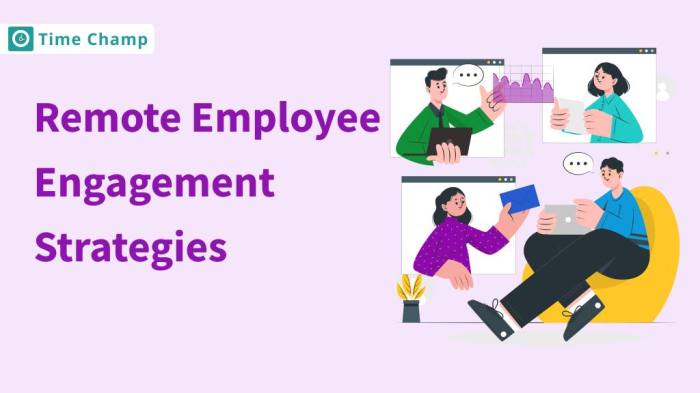
Role of HR in employee engagement for remote teams is crucial for success. Remote work presents unique challenges and opportunities for boosting morale and productivity. This exploration delves into how HR can foster a sense of connection, support work-life balance, and implement effective communication strategies to keep remote employees engaged and motivated.
We’ll examine the key differences between in-person and remote engagement strategies, and highlight the specific role HR plays in building a positive and productive remote work environment. From communication tools to performance management, this deep dive will cover every aspect of creating a thriving remote workforce.
Defining Remote Employee Engagement
Remote employee engagement is more than just checking in on team members. It’s a multifaceted approach to fostering a sense of belonging, purpose, and connection among employees working from diverse locations. It requires a tailored strategy that goes beyond the typical in-office engagement tactics and acknowledges the unique challenges and opportunities of a distributed workforce. Effective remote engagement isn’t just about productivity; it’s about cultivating a thriving and supportive remote environment where employees feel valued, heard, and motivated.Understanding the nuances of remote engagement is crucial for HR professionals.
Strategies must account for the lack of spontaneous interactions, the need for clear communication channels, and the importance of fostering a sense of community in a virtual space. This proactive approach helps build trust, improve employee morale, and ultimately drive business success.
Key Differences Between In-Person and Remote Engagement Strategies
In-person engagement often relies on spontaneous interactions, informal team gatherings, and readily available feedback mechanisms. Remote engagement, conversely, requires more structured communication channels, virtual team-building activities, and proactive methods to solicit feedback. The reliance on technology necessitates a focus on digital tools and platforms to facilitate connection and collaboration.
Unique Challenges and Opportunities in Remote Teams
Remote work presents unique challenges for engagement. The lack of physical presence can lead to feelings of isolation and disconnection. Effective communication becomes even more critical, requiring clear guidelines, frequent check-ins, and a variety of communication channels to ensure everyone feels heard and included. However, remote work also offers significant opportunities. Employees can often achieve a better work-life balance, leading to increased job satisfaction and reduced stress.
A geographically diverse workforce can also provide access to a wider pool of talent.
The Role of Trust and Communication in Fostering Engagement
Trust is paramount in remote teams. Open communication channels, transparent leadership, and consistent feedback are essential to build and maintain trust. Regular check-ins, team meetings, and opportunities for social interaction are vital. Clear expectations, guidelines, and access to support resources help remote employees feel empowered and secure. Honest and timely communication is critical to maintain morale and prevent misunderstandings.
Comparing Engagement Metrics for In-Person and Remote Teams
| Metric | In-Person Team | Remote Team |
|---|---|---|
| Employee Turnover Rate | Measured through employee exit interviews and analysis of attrition rates. | Measured through exit surveys, analysis of voluntary departures, and tracking of remote employee satisfaction. |
| Employee Satisfaction Surveys | Collected through questionnaires and feedback sessions. | Collected through online surveys, feedback platforms, and regular check-in discussions. |
| Productivity Metrics | Measured through project completion times, output volume, and task completion rates. | Measured through project completion times, output volume, task completion rates, and adherence to deadlines. |
| Team Collaboration and Communication | Observed through informal interactions, project meetings, and cross-departmental interactions. | Measured through the frequency and effectiveness of virtual meetings, team communication channels, and project collaboration platforms. |
This table illustrates how engagement metrics can be adapted to accurately reflect the realities of a remote workforce. Crucially, data collected from remote teams should account for the distinct nature of communication and interaction in this environment.
HR’s Role in Fostering Remote Team Connection

HR plays a critical role in bridging the communication gap and fostering a sense of community among remote employees. Effective HR strategies are essential to combat feelings of isolation and ensure remote teams thrive. This involves proactively designing initiatives that build camaraderie, promote virtual social interactions, and encourage open communication. By focusing on employee well-being and work-life balance, HR can empower remote teams to achieve peak performance.Creating a strong sense of connection is paramount in a remote work environment.
It’s no longer enough to simply provide the tools and technology; HR must actively cultivate a supportive and inclusive atmosphere. This involves creating opportunities for employees to connect on a personal level, building trust, and encouraging collaboration beyond task completion. The strategies below Artikel how HR can successfully foster these crucial connections.
Strategies for Building Remote Team Community
HR can implement several strategies to build a strong sense of community among remote employees. These initiatives should focus on fostering a sense of belonging and encourage interaction beyond work-related tasks. Establishing clear communication channels and promoting regular social interaction are key to achieving this.
- Establishing Virtual Social Interaction Platforms: Dedicated platforms for casual conversations and informal interactions are crucial. These platforms could include virtual coffee breaks, online game nights, or social media groups specifically for remote teams. For example, a Slack channel dedicated to sharing personal interests, or a dedicated Zoom call for casual conversations outside of work-related meetings can facilitate a sense of community.
- Implementing Regular Virtual Team-Building Activities: These activities can range from online quizzes and games to virtual team lunches or volunteering opportunities. These activities are designed to help employees connect on a personal level and develop camaraderie. For example, a virtual escape room, or a themed online movie night can foster interaction and fun, while a virtual volunteer event can create a shared purpose and a sense of connection outside the workspace.
- Promoting Regular Check-ins and Feedback Mechanisms: Regular check-ins provide a structured way for managers to connect with their remote team members. These check-ins can include casual conversations about personal well-being, work progress, or challenges faced. Feedback mechanisms, such as anonymous surveys or regular feedback sessions, allow employees to share their thoughts and concerns, fostering a culture of open communication.
- Supporting Remote Employees’ Work-Life Balance: HR should actively promote and support healthy work-life boundaries for remote employees. This includes initiatives like flexible work hours, generous vacation time, and resources for stress management. Examples include access to online wellness programs, or offering a flexible work schedule, which can contribute to a more balanced work environment and improve employee satisfaction.
- Providing Examples of Remote Team-Building Activities: HR can initiate and support diverse team-building activities. These can include virtual book clubs, online cooking classes, or even virtual volunteering events. These activities promote connection and collaboration in a fun and engaging way. A virtual book club, for example, provides a structured way for remote employees to engage in a shared interest, building a sense of connection and shared experience.
Monitoring and Addressing Employee Well-being
HR needs a framework to actively monitor and address employee well-being in remote settings. This proactive approach is crucial to ensure that employees feel supported and can effectively manage the challenges of remote work.
- Implementing a Comprehensive Well-being Framework: This framework should include regular pulse surveys to assess employee well-being, providing resources for stress management and mental health support, and offering training for managers on recognizing and addressing employee concerns. The framework could incorporate weekly check-ins to understand employee mental well-being, along with providing resources for managing stress and burnout. This could involve offering access to counseling services or wellness programs.
- Creating a Support Network: Establishing a support network through mentorship programs or peer-to-peer support groups can help remote employees feel connected and less isolated. Creating a mentorship program where experienced remote workers guide newer hires can provide support and guidance in navigating the remote work environment. Peer support groups, whether facilitated online or via virtual meeting, can offer a safe space for employees to share experiences and provide support to one another.
Communication and Collaboration Tools
Staying connected is crucial for remote teams. Effective communication tools bridge the geographical gap, fostering collaboration and ensuring projects stay on track. Without the inherent cues of in-person interaction, clear and consistent communication becomes even more critical for maintaining productivity and morale. This section delves into the vital role of communication and collaboration tools in supporting remote employee engagement.
Importance of Effective Communication Tools
Robust communication tools are essential for remote teams to maintain productivity, foster a sense of belonging, and drive project success. They allow for real-time interaction, quick information sharing, and efficient problem-solving. Effective communication tools facilitate seamless information flow, minimizing misunderstandings and ensuring everyone is on the same page. This, in turn, reduces frustration and increases team satisfaction.
Examples of Communication Tools HR Can Leverage
HR can leverage a diverse range of communication tools to support remote employees. These tools should cater to various communication styles and preferences. Examples include project management platforms like Asana or Trello, video conferencing software like Zoom or Google Meet, instant messaging platforms like Slack or Microsoft Teams, and dedicated communication channels for specific teams or projects. These platforms are often integral in fostering a sense of community and connection within remote teams.
HR plays a crucial role in boosting employee engagement for remote teams, especially now. With the recent Twitter hack highlighting the growing need for robust security measures, companies need to ensure their remote workers feel safe and secure in their digital environments. This underscores the importance of HR’s role in proactively addressing employee concerns and providing clear, consistent security guidelines, fostering a sense of trust and control within the remote workforce.
HR’s responsibility now goes beyond basic benefits and extends to proactively managing the security anxieties that can arise from situations like the recent twitter hack ratchets up security jitters. Ultimately, a secure and engaged remote workforce is key to long-term success.
Comparison of Communication Platforms, Role of hr in employee engagement for remote teams
Different communication platforms cater to different needs. Project management platforms are ideal for task assignment, progress tracking, and documentation. Video conferencing excels in facilitating face-to-face interaction, fostering stronger relationships and enabling better understanding. Instant messaging is best for quick questions and updates, keeping the team informed in real-time. Selecting the right platform for a particular task or team ensures efficient communication and minimizes the potential for miscommunication.
Significance of Clear Communication Channels
Establishing clear communication channels is paramount for remote teams. Teams need to know who to contact for specific issues, and what methods are appropriate for different types of communication. A clear hierarchy and defined communication protocols prevent information overload and ensure that messages are received and processed effectively. This clarity fosters trust and reduces ambiguity.
Best Practices for Utilizing Project Management Software
Project management software should be utilized strategically. Tasks should be clearly defined, deadlines should be set, and progress should be tracked regularly. This ensures that projects stay on schedule and that all team members are aware of their responsibilities. Using project management software in a consistent manner can lead to better project outcomes. Templates, guidelines, and training on using the chosen platform are vital for successful integration.
Role of Instant Messaging in Fostering Real-Time Communication
Instant messaging (IM) platforms facilitate real-time communication, crucial for addressing urgent issues and keeping the team connected. Quick responses and immediate feedback are key benefits of using IM, allowing for a more dynamic and responsive work environment. Clear guidelines regarding appropriate use, frequency, and tone are important to maintain professionalism and avoid misinterpretations.
Communication Tools and Their Potential Benefits
| Communication Tool | Potential Benefits |
|---|---|
| Project Management Software (Asana, Trello) | Task assignment, progress tracking, collaboration, documentation, improved project management |
| Video Conferencing (Zoom, Google Meet) | Face-to-face interaction, improved understanding, stronger relationships, better communication of complex information |
| Instant Messaging (Slack, Microsoft Teams) | Real-time communication, quick responses, quick updates, immediate feedback, better collaboration |
| Dedicated Communication Channels | Focus on specific projects or teams, reduces information overload, maintains clarity of communication channels |
Performance Management and Recognition
Remote work presents unique challenges for performance management. Maintaining accountability and recognizing contributions while fostering a sense of connection across geographical boundaries is crucial. Effective performance management in this context requires a shift in approach, emphasizing transparency, open communication, and personalized strategies. It’s about building trust and understanding, not just measuring outputs.Performance management in remote settings isn’t about micromanagement but about enabling employees to succeed.
HR plays a crucial role in boosting employee engagement for remote teams, especially in today’s work-from-anywhere world. It’s about fostering a sense of community and connection, which is harder to achieve remotely. Think about how some of those crazy people running the US government and News Corp need new jobs ( those crazy people running the US government and News Corp need new jobs ) – a strong HR strategy can help prevent similar issues and build a thriving remote workforce.
Good communication, flexible policies, and regular check-ins are key elements for HR to succeed in this area.
It demands a proactive and supportive approach, ensuring clear expectations, providing ample support, and fostering a culture of continuous improvement. Regular feedback and recognition are key elements in motivating remote employees and driving performance.
Effective Remote Performance Management Methods
Remote performance management needs a tailored approach. Instead of relying solely on traditional metrics, managers should incorporate qualitative assessments and regular check-ins to understand the context of the work. Clear communication of expectations and objectives, combined with flexible deadlines and support systems, is paramount. This approach fosters a sense of autonomy and trust.
Performance Metrics Tailored for Remote Work
Metrics should align with remote work realities. Instead of solely focusing on hours worked, consider project completion rates, quality of deliverables, and positive impact on team goals. Collaboration metrics, such as participation in virtual meetings and contributions to shared documents, can also be valuable indicators. Time management and efficiency in handling remote tasks can be measured through project completion timelines and adherence to deadlines.
Finally, consider employee feedback on work processes and the overall remote work environment, gauging the effectiveness of tools and strategies.
The Role of Recognition and Rewards in Motivating Remote Employees
Recognition and rewards are vital for motivating remote employees. Public acknowledgment of achievements, whether through team shout-outs, company-wide emails, or small token gifts, can significantly boost morale. Recognizing both individual and team accomplishments fosters a sense of community and belonging. Personalized rewards, such as gift cards or extra time off, can be powerful motivators, catering to individual preferences.
Adapting Performance Reviews for Remote Teams
Performance reviews need adaptation for remote settings. Shifting from traditional in-person reviews to virtual meetings allows for more flexibility and accessibility. Utilize video conferencing for face-to-face interactions, ensuring a comfortable and productive review process. Pre-review preparation through documented achievements and clear discussion points ensures a focused and efficient conversation. Documentation of feedback and action plans from both parties, followed by agreed-upon follow-up steps, strengthens the review process.
Ensuring Fair and Transparent Performance Evaluations for Remote Workers
Transparency and fairness are paramount in remote performance evaluations. Clearly defined performance standards, communicated in advance, create a level playing field. Utilizing a standardized evaluation template with clear criteria helps avoid bias. Seeking feedback from peers and stakeholders can offer a well-rounded perspective. Regular feedback loops throughout the review period ensure ongoing support and allow for adjustments as needed.
The Importance of Regular Feedback Sessions for Remote Teams
Regular feedback sessions are essential for remote teams. They facilitate ongoing communication, address concerns promptly, and foster a culture of continuous improvement. Scheduled one-on-one meetings, team check-ins, and progress reports provide opportunities for open dialogue. Utilizing a feedback system that encourages open dialogue between managers and employees can significantly improve performance and engagement. Using feedback forms and encouraging two-way communication channels helps foster a transparent and supportive environment.
Training and Development Opportunities: Role Of Hr In Employee Engagement For Remote Teams
Remote work necessitates a flexible and adaptable approach to employee training and development. Effective programs empower remote teams to thrive in a distributed environment, fostering a culture of continuous learning and professional growth. This focus on upskilling and reskilling is crucial for maintaining competitive edge and enhancing employee engagement.Investing in training and development is not just about providing knowledge; it’s about building a culture of continuous learning and personal growth within the remote workforce.
Tailoring these opportunities to the specific needs of remote employees is essential for maximizing their effectiveness and engagement. This involves understanding the unique challenges and opportunities of remote work and crafting programs that address them directly.
Effective Training Programs for Remote Teams
Training programs for remote teams need to consider the unique challenges and opportunities of this work model. Interactive online modules, virtual workshops, and collaborative learning platforms are particularly well-suited for remote settings. Microlearning modules, easily digestible chunks of information, are also effective in keeping remote employees engaged. Emphasis should be placed on practical application and hands-on exercises to ensure knowledge retention and skill development.
HR plays a crucial role in boosting employee engagement for remote teams, fostering a sense of community and connection. Keeping everyone motivated and productive, especially in the face of remote work challenges, is key. Think about how that relates to the tech world; recent news about Sony Ericsson starting some early buzz for a late Android highlights the constant evolution in remote work environments.
Ultimately, HR needs to adapt to these changes, offering support and resources to keep employees engaged and thriving, regardless of location.
Real-world scenarios and case studies are effective in illustrating how these skills can be applied in various situations.
Designing a Training Module on Remote Work Best Practices for HR Professionals
A training module for HR professionals on remote work best practices should cover crucial aspects of managing remote teams effectively. This module should delve into the practical aspects of remote work management, encompassing communication strategies, performance management techniques, and the importance of fostering a sense of community and connection among remote employees. The training should emphasize the importance of adapting traditional HR practices to the remote work environment.
It should cover tools and strategies for virtual team building, and the importance of creating a positive and inclusive remote work culture. Practical exercises and case studies are essential to illustrate the application of these concepts.
Providing Opportunities for Professional Development for Remote Employees
Creating opportunities for professional development for remote employees necessitates a flexible approach. This involves offering a variety of learning resources, including online courses, webinars, and mentorship programs. The accessibility of these resources is paramount. Flexible scheduling is crucial for remote employees, allowing them to participate in training without compromising their work-life balance. Mentorship programs play a critical role in supporting professional growth.
Remote employees can benefit from pairing with experienced professionals who can offer guidance and support.
Upskilling and Reskilling for Remote Teams
Upskilling and reskilling are critical for remote teams to remain competitive in a rapidly changing technological landscape. These initiatives are essential to adapt to new technologies and industry trends. Training programs should focus on the specific skills and technologies relevant to the remote employees’ roles and the company’s strategic goals. This proactive approach will empower remote employees to adapt to new challenges and opportunities.
Examples include training in cloud computing, project management software, or specific industry-related software.
Mentorship Programs to Support Remote Employee Growth
Mentorship programs offer invaluable support to remote employees. Pairing experienced professionals with newer employees fosters knowledge sharing and career development. These programs offer guidance and support, enhancing professional growth and creating a strong sense of community. Mentors can provide tailored guidance based on the mentee’s specific needs and career goals. Regular check-ins and feedback sessions are essential to ensure the mentorship is effective and fulfilling for both parties.
Tailoring Training Programs to the Needs of Remote Teams
Tailoring training programs to the needs of remote teams requires a deep understanding of their specific requirements. This involves assessing the team’s current skill gaps, identifying their specific needs, and designing programs that address those needs directly. Consider the unique challenges and opportunities of remote work, such as time zone differences and varying access to resources. Flexible scheduling, diverse learning formats, and ongoing communication are crucial components of effective training programs for remote teams.
Technology Support and Resources

Remote work thrives on reliable technology. Without seamless access to tools and dependable support, even the most engaged employees can struggle. Providing robust technology support isn’t just a perk; it’s a necessity for a productive and positive remote work environment. It empowers employees to focus on their tasks, fostering a sense of confidence and control.A key aspect of employee engagement in remote settings is ensuring that the tools employees need are readily available and effectively supported.
HR plays a crucial role in this by acting as a liaison between employees and IT, ensuring smooth operations and minimizing disruptions. This involves proactively addressing potential tech issues and providing timely solutions, which directly impacts employee morale and productivity.
Importance of Adequate Technology Support
Reliable technology is fundamental to remote work success. It allows employees to connect with colleagues, access necessary resources, and complete their tasks efficiently. When technology fails, productivity plummets, morale suffers, and the overall employee experience deteriorates. Robust technology support is not just about fixing problems; it’s about preventing them in the first place through proactive measures and a well-defined support system.
HR’s Role in Troubleshooting Technology Issues
HR acts as a vital bridge between employees and IT support. This involves promptly escalating employee technology issues to the appropriate IT personnel. Effective communication channels and clear escalation procedures are essential. HR can also provide initial troubleshooting assistance, gather necessary information from employees, and ensure a smooth process for resolution. This proactive approach minimizes downtime and fosters a sense of support for remote workers.
Ensuring Reliable Internet Access for Remote Workers
Reliable internet access is paramount for remote work. HR can collaborate with IT to identify areas with unreliable internet connectivity and explore solutions. This might include providing stipends for improved internet services, recommending local internet providers, or even offering temporary hot-spot solutions. The goal is to equip remote employees with the resources they need to maintain consistent connectivity.
Examples of IT Support Resources for Remote Employees
Various resources can enhance remote employee support. These can include dedicated IT support phone lines, online portals for self-service solutions, and readily available FAQs. A comprehensive knowledge base with clear and concise information about common issues, step-by-step troubleshooting guides, and tutorials can empower employees to resolve many problems independently. Quick and effective access to IT support minimizes downtime and maintains productivity.
Best Practices for Addressing Technology-Related Challenges
Proactive measures are key to addressing technology-related challenges. Regular check-ins with remote employees to assess their tech needs, creating a feedback loop for IT to improve their support system, and implementing preventative maintenance are crucial. This includes proactively identifying and addressing potential issues before they escalate into major problems. Regular training sessions for employees on the use of various technology tools can also help reduce frustration and enhance efficiency.
Essential IT Support Resources for Remote Employees
| Resource Category | Description | Importance |
|---|---|---|
| Dedicated IT Support Line | A direct line to IT support staff. | Provides immediate assistance during critical issues. |
| Online Support Portal | A website or platform with self-service options. | Enables employees to troubleshoot issues independently. |
| Comprehensive FAQs | Frequently Asked Questions database. | Provides quick answers to common problems. |
| Troubleshooting Guides | Step-by-step instructions for resolving technical issues. | Empowers employees to resolve issues independently. |
| Remote Access Support | Assistance in securely accessing company resources. | Ensures consistent access to vital data and applications. |
| VPN Access | Virtual Private Network for secure connectivity. | Protects sensitive data and company information. |
Building a Culture of Trust and Transparency
Cultivating a strong sense of trust and transparency is paramount for fostering a thriving remote work environment. Remote teams, often geographically dispersed, face unique challenges in building camaraderie and fostering a shared sense of purpose. Open communication and a transparent approach are crucial for bridging these gaps and creating a positive and productive work atmosphere. HR plays a pivotal role in shaping this environment, ensuring that remote employees feel valued, understood, and connected to the organization.Establishing a culture of trust and transparency requires a proactive and intentional approach.
It’s not simply about implementing policies; it’s about creating a mindset where open communication and shared understanding are prioritized. This means actively seeking feedback, responding promptly to concerns, and demonstrating genuine interest in the well-being of remote employees.
Strategies for Fostering Trust
Fostering trust requires a multifaceted approach. Transparency in decision-making processes, clear communication channels, and opportunities for open dialogue are essential components. This approach cultivates a sense of psychological safety where employees feel comfortable sharing their perspectives and concerns without fear of judgment.
- Establish Clear Communication Channels: Implementing various communication tools, such as dedicated Slack channels for specific projects or teams, and regular company-wide newsletters, ensures consistent and accessible information flow. This minimizes misunderstandings and keeps everyone informed.
- Encourage Open Feedback Mechanisms: Implementing regular feedback loops through surveys, suggestion boxes, or dedicated feedback sessions allows employees to voice their concerns and contribute to improvements in processes and policies. This demonstrates a genuine commitment to employee input.
- Promote Transparency in Decision-Making: Sharing the rationale behind decisions, especially those impacting remote teams, fosters trust and understanding. Providing context helps employees feel more involved and valued.
Creating a Sense of Belonging
A strong sense of belonging is vital for remote employees to feel connected and motivated. This requires intentional efforts to foster community and social interaction.
- Organize Virtual Social Events: Regular virtual coffee breaks, team lunches, or social gatherings can help remote teams connect on a personal level, fostering camaraderie and a sense of community. These events can be informal or structured, depending on the preferences of the team.
- Encourage Team Building Activities: Online games, virtual team challenges, or shared learning opportunities can foster collaboration and build relationships. These activities create a platform for employees to connect outside of their immediate work tasks.
- Implement Remote Team Building Activities: Virtual team building activities, like escape rooms or collaborative projects, can foster creativity and camaraderie. These activities help employees connect on a more personal level, leading to stronger relationships.
Importance of Clear Expectations and Guidelines
Defining clear expectations and guidelines is essential for remote teams to thrive. This clarity helps everyone understand their roles and responsibilities, fostering accountability and reducing ambiguity.
- Establish Clear Roles and Responsibilities: Well-defined roles and responsibilities for each team member contribute to a more efficient and transparent workflow. Clear communication of roles ensures everyone understands their contribution to the team’s success.
- Develop Remote Work Policies: Comprehensive remote work policies provide clear guidelines on communication protocols, work hours, and expectations. This structure helps employees feel secure and understood in their remote work environment.
- Provide Access to Resources and Support: Providing access to the necessary tools, training, and support ensures that remote employees have the resources to perform their duties effectively. This includes technology support, training materials, and access to colleagues.
Cultivating a Positive Work Environment
Creating a positive work environment for remote employees involves proactive strategies that prioritize employee well-being and support.
- Prioritize Employee Well-being: Implement policies that promote work-life balance and address the unique challenges of remote work, such as flexible scheduling or remote work hours. This shows employees that their well-being is a priority.
- Encourage Regular Check-ins: Implementing regular one-on-one meetings with managers and team members allows for open communication and addresses any concerns promptly. These check-ins provide a safe space to discuss any issues or challenges that may arise.
- Promote a Culture of Recognition and Appreciation: Recognize and reward employee contributions, both big and small, to foster a positive work environment. Public acknowledgement or personalized appreciation notes can significantly boost morale.
Examples of Policies and Procedures
Policies and procedures should be tailored to the specific needs of the remote team and the organization’s culture.
- Remote Work Policy: A clear policy outlining expectations for work hours, communication protocols, and technology usage sets the stage for a productive remote environment.
- Feedback Mechanisms: Establishing regular feedback channels, such as surveys or feedback forms, creates a platform for open communication and allows employees to contribute to the team’s improvement.
- Employee Recognition Programs: Implementing programs that acknowledge and reward employee contributions, whether through public recognition or small tokens of appreciation, cultivates a positive and supportive atmosphere.
Final Thoughts
Ultimately, successful remote employee engagement hinges on a proactive HR approach. By understanding the unique needs of remote teams and implementing tailored strategies for communication, support, and recognition, HR can cultivate a strong sense of belonging and drive exceptional performance. This approach not only enhances employee well-being but also unlocks the full potential of remote teams.






